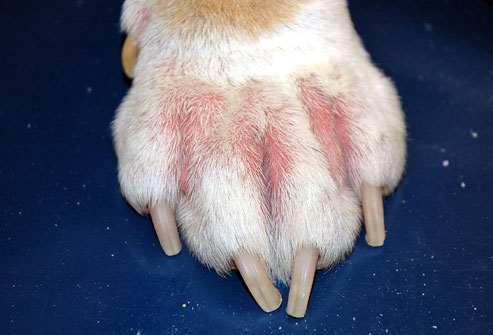
What is Canine Atopic Dermatitis?
Also known as:
Pet Atopy, Pet Atopic Dermatitis, Pet Skin Allergies
Canine atopic dermatitis is a skin problem caused by airborne allergens such as dust mites, pollen, dander, and other microorganisms. Severe itching and other issues, such as ear infections, triggered by canine atopic dermatitis are among the leading claims submitted by pet insurance policyholders. Although symptoms are similar, pet atopy differs from parasitic dermatitis and skin conditions caused by poor diet or food allergies.
Aerapy Animal Health’s UV sanitizing technology can help clean and purify indoor air of allergy triggers.
Learn more about the story behind one pet’s allergies and the creation of Aerapy Animal Health.
What causes canine atopic dermatitis?
Pet owners are often surprised to learn that atopic dermatitis is caused by airborne allergens, even though the symptoms show up on the skin. The basic definition of this common skin problem is a predisposition to develop allergic symptoms following exposure to substances that are usually harmless but have triggered an allergic response.
Two of the most prevalent offenders are dust mites and pollen, which are difficult for pets to avoid as dust mites are virtually everywhere and pollen permeates the air outdoors (and which inevitably makes its way into your indoor environment). Moreover, an allergy to pollen can trigger allergic reactions to other environmental allergens because seasonal allergies in pets commonly trigger hypersensitivity.
How is canine atopic dermatitis transmitted?
Unlike other pet diseases, canine atopic dermatitis isn’t transmitted in the sense your pet can “catch” it from another pet like dog flu, canine (kennel) cough, or feline calicivirus. Rather, it is triggered by allergic reactions to pollen, dust, dust mites and other airborne environmental allergens. Some dogs are more prone to developing allergies than other dogs. For example, canine atopic dermatitis is especially prevalent in boxers, bulldogs, retrievers, Shar-Peis, beagles, Dalmatians, and Irish setters. Overall, the incidence of atopic dermatitis in dogs and cats appears to be increasing.
Because some skin problems in dogs are caused by parasitic dermatitis, an allergic response to the saliva of fleas, or may be a reaction to a poor diet or a food sensitivity, it’s important to consult your veterinarian.
What are the symptoms of canine atopic dermatitis?
Common symptoms of pet atopy and canine atopic dermatitis, in particular, include:
- Excessive scratching and itching of the eyes, mouth, ears, and paws.
- Inflamed skin that is hot to the touch (lesions).
- Recurrent ear infections.
- Excessive chewing on the paws and areas such as the groin and armpits.
- Scaly or greasy skin with flaking that resembles dandruff.
- A strong, unpleasant skin odor.
- Rubbing on the carpet.
- Hair loss (alopecia).
Over time, the scratched skin can develop hot spots—raw, inflamed areas—that may become infected. Even though pet atopy can develop as early as six months old, or sooner, as pets age they may become more sensitive to airborne allergens. Further, once pet atopy is developed, they may increasingly suffer as their skin becomes more sensitive over time.
If you have a dog or cat with seasonal allergies, you may notice their symptoms are lasting longer or are more severe. What was seasonal pet atopy, in the spring or fall, may become a year-round problem. Additionally, neurogenic dermatitis may develop even after an animal is treated for skin allergies as they won’t stop “worrying” or chewing at the area.
How can canine atopic dermatitis be prevented?
Unlike other pet illnesses, there is not a vaccine for canine atopic dermatitis and, as any human with environmental allergies can attest, normal surface cleaning can’t tackle airborne environmental allergens. For years, Aerapy Animal Health’s founder, Annette Uda, was on a quest to solve her dog Tasha’s environmental allergies that left Tasha uncomfortable with sores, ear infections, loss of hair, and more. Tasha’s allergies became so severe that she was at the veterinarian’s office at least five times a year trying to get her symptoms under control and to help make her comfortable.
Tasha was given steroids, medicated shampoos, antibiotics, etc. After several attempts to find out what her dog was allergic to, Annette was told it was pet atopy. Annette asked her veterinarian if there was anything she could do to prevent her dog from getting sick. Her vet told her, “if you can control the source of the environmental allergies you can control the problem.” And that is what Annette set out to do with UV.
While you can’t avoid pollen and other outdoor environmental allergens entirely as your pet will spend time outside, you can minimize the potential for an allergic reaction by cleaning the indoor air of triggers. Aerapy Animal Health’s UV systems, in combination with an allergen filter, can help remove airborne allergens such as pollen and can help kill or inactivate airborne microorganisms such as mold.
How is canine atopic dermatitis treated?
The following is not intended as a substitute for professional medical advice, diagnosis, or treatment for your pet. Consult your veterinarian for questions and information regarding your pet’s health.
Pets that develop signs of atopic dermatitis should be seen by a veterinarian as soon as possible. Steroids or anti-itch shampoos can help relieve the itching in the short-term, and antihistamines or fatty acid therapy can help get the allergies under control for a period of time. In severe cases, where the skin is infected, antibiotics may be needed to clear up the damage. If allergies persist, regular desensitization shots may be required. It’s also important to minimize a pet’s exposure to allergens, otherwise they will return once treatment is halted.
CANINE ATOPIC DERMATITIS QUICK LINKS
What causes canine atopic dermatitis?
Pet owners are often surprised to learn that atopic dermatitis is caused by airborne allergens, even though the symptoms show up on the skin. The basic definition of this common skin problem is a predisposition to develop allergic symptoms following exposure to substances that are usually harmless but have triggered an allergic response.
Two of the most prevalent offenders are dust mites and pollen, which are difficult for pets to avoid as dust mites are virtually everywhere and pollen permeates the air outdoors (and which inevitably makes its way into your indoor environment). Moreover, an allergy to pollen can trigger allergic reactions to other environmental allergens because seasonal allergies in pets commonly trigger hypersensitivity.
How is canine atopic dermatitis transmitted?
Unlike other pet diseases, canine atopic dermatitis isn’t transmitted in the sense your pet can “catch” it from another pet like dog flu, canine (kennel) cough, or feline calicivirus. Rather, it is triggered by allergic reactions to pollen, dust, dust mites and other airborne environmental allergens. Some dogs are more prone to developing allergies than other dogs. For example, canine atopic dermatitis is especially prevalent in boxers, bulldogs, retrievers, Shar-Peis, beagles, Dalmatians, and Irish setters. Overall, the incidence of atopic dermatitis in dogs and cats appears to be increasing.
Because some skin problems in dogs are caused by parasitic dermatitis, an allergic response to the saliva of fleas, or may be a reaction to a poor diet or a food sensitivity, it’s important to consult your veterinarian.
What are the symptoms of canine atopic dermatitis?
Common symptoms of pet atopy and canine atopic dermatitis, in particular, include:
- Excessive scratching and itching of the eyes, mouth, ears, and paws.
- Inflamed skin that is hot to the touch (lesions).
- Recurrent ear infections.
- Excessive chewing on the paws and areas such as the groin and armpits.
- Scaly or greasy skin with flaking that resembles dandruff.
- A strong, unpleasant skin odor.
- Rubbing on the carpet.
- Hair loss (alopecia).
Over time, the scratched skin can develop hot spots—raw, inflamed areas—that may become infected. Even though pet atopy can develop as early as six months old, or sooner, as pets age they may become more sensitive to airborne allergens. Further, once pet atopy is developed, they may increasingly suffer as their skin becomes more sensitive over time.
If you have a dog or cat with seasonal allergies, you may notice their symptoms are lasting longer or are more severe. What was seasonal pet atopy, in the spring or fall, may become a year-round problem. Additionally, neurogenic dermatitis may develop even after an animal is treated for skin allergies as they won’t stop “worrying” or chewing at the area.
How can canine atopic dermatitis be prevented?
Unlike other pet illnesses, there is not a vaccine for canine atopic dermatitis and, as any human with environmental allergies can attest, normal surface cleaning can’t tackle airborne environmental allergens. For years, Aerapy Animal Health’s founder, Annette Uda, was on a quest to solve her dog Tasha’s environmental allergies that left Tasha uncomfortable with sores, ear infections, loss of hair, and more. Tasha’s allergies became so severe that she was at the veterinarian’s office at least five times a year trying to get her symptoms under control and to help make her comfortable.
Tasha was given steroids, medicated shampoos, antibiotics, etc. After several attempts to find out what her dog was allergic to, Annette was told it was pet atopy. Annette asked her veterinarian if there was anything she could do to prevent her dog from getting sick. Her vet told her, “if you can control the source of the environmental allergies you can control the problem.” And that is what Annette set out to do with UV.
While you can’t avoid pollen and other outdoor environmental allergens entirely as your pet will spend time outside, you can minimize the potential for an allergic reaction by cleaning the indoor air of triggers. Aerapy Animal Health’s UV systems, in combination with an allergen filter, can help remove airborne allergens such as pollen and can help kill or inactivate airborne microorganisms such as mold.
How is canine atopic dermatitis treated?
The following is not intended as a substitute for professional medical advice, diagnosis, or treatment for your pet. Consult your veterinarian for questions and information regarding your pet’s health.
Pets that develop signs of atopic dermatitis should be seen by a veterinarian as soon as possible. Steroids or anti-itch shampoos can help relieve the itching in the short-term, and antihistamines or fatty acid therapy can help get the allergies under control for a period of time. In severe cases, where the skin is infected, antibiotics may be needed to clear up the damage. If allergies persist, regular desensitization shots may be required. It’s also important to minimize a pet’s exposure to allergens, otherwise they will return once treatment is halted.





